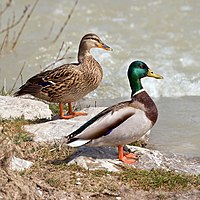
Photo from wikipedia
Avian influenza viruses (AIV) are a worldwide threat to animal and human health. As wild waterfowl circulate and spread these viruses around the world, investigations of AIV prevalence in wild… Click to show full abstract
Avian influenza viruses (AIV) are a worldwide threat to animal and human health. As wild waterfowl circulate and spread these viruses around the world, investigations of AIV prevalence in wild populations are critical for understanding pathogen transmission, as well as predicting disease outbreaks in domestic animals and humans. Surveillance efforts in this study have isolated H4N6 for the first time in Israel from a faecal sample of a wild mallard (Anas platyrhynchos). Phylogenetic analyses of the HA and NA genes revealed that this strain is closely related to isolates from Europe and Asia. This Eurasian origin, together with Israel serving as an important migratory bottleneck of the mid Palearctic-African flyway, suggests a potential introduction of this strain by migratory birds. Additional phylogenetic analysis of the isolate's internal genes (PB1, PB2, PA, NP, M, NS) revealed high levels of phylogenetic relatedness with other AIV subtypes, indicating previous reassortment events. High reassortment rates are characteristic for H4N6 viruses, which, together with this subtype's ability to infect pigs and adaptability to the human receptor binding domain, raises the concern that it would potentially become zoonotic in the future. These results emphasise the importance of continuous AIV monitoring in migratory birds. This article is protected by copyright. All rights reserved.
Journal Title: Transboundary and emerging diseases
Year Published: 2022
Link to full text (if available)
Share on Social Media: Sign Up to like & get
recommendations!